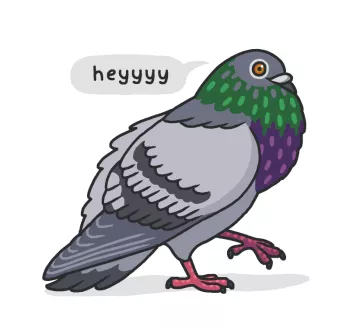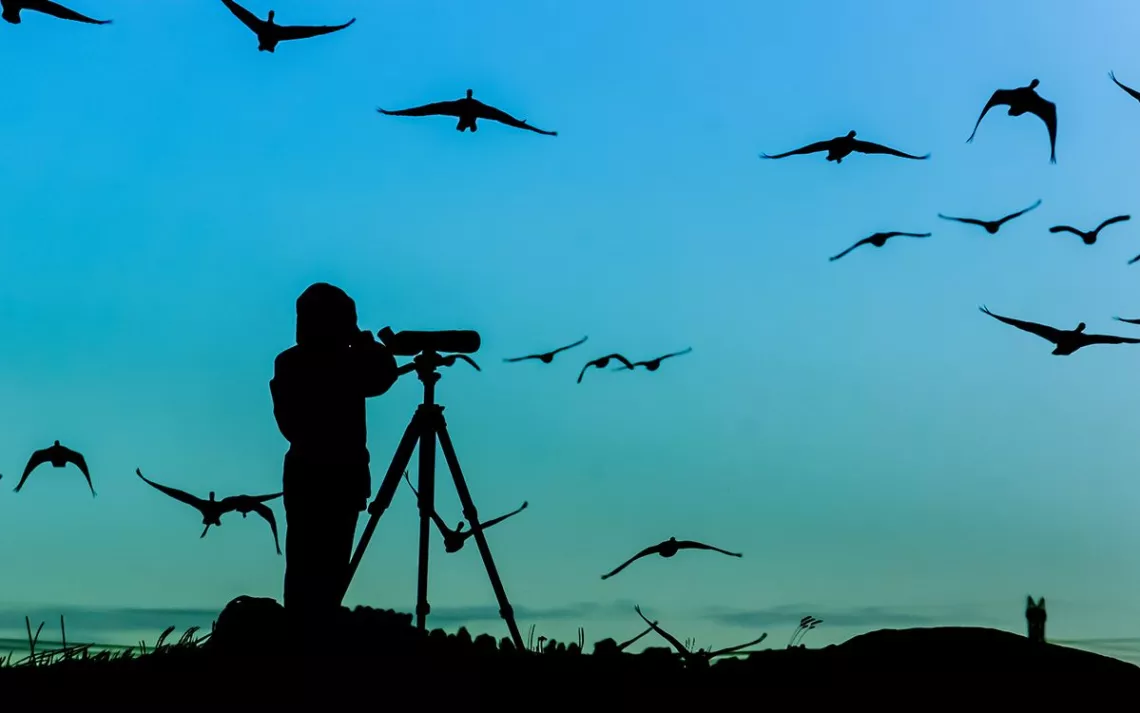Birds Need Us More Than Ever—So How Do We Make Birding More Accessible?
New books and tools prove birds are for everyone (and pretty fun too)
In the early months of the pandemic, usage of Cornell Lab of Ornithology’s eBird app to record bird sightings soared. Not only did watching birds prove particularly well-suited to social-distancing protocols but it also provided much-needed solace and a welcome escape from the chaos that engulfed the rest of our lives. Along with the increase in casual birders came a surge in backyard bird paraphernalia sales—from seed to feeders, and even to luxurious bird baths.
And yet, the birds we’ve come to love—and the ones we’re now talking about and watching in our backyards with renewed vigor—are in serious trouble. Since 1970, wild bird populations in North America have declined 30 percent, and we’ve lost more than 2.9 billion birds. Put differently, the alarming waves of avian losses mean that birds need us more than ever. Most distressing is the fact that birds are indicator species—canaries in the coal mine—and their dramatic plunge in numbers is a prelude to a larger environmental collapse. Birds have disappeared in every single biome, with grassland birds showing the sharpest drop, declining by more than 50 percent, or more than 700 million birds. Even the population of red-winged blackbirds, harbingers of spring in the northeast, has shrunk by more than 400 million.

The stark numbers must not be downplayed, but as author and environmentalist Melissa Harrison says, “If the only way we encounter nature is through guilt and fear, the danger is we just stop listening.” So how do we ensure that novice birders not only keep listening but also keep caring and fighting for the avian creatures they’ve grown to love during the pandemic?
The answer might lie in making birding more accessible to people of all skill levels. Let’s be honest—birding can be an intimidating enterprise. The lingo can feel esoteric, the optics-talk can be off-putting, the acronyms can seem like code-speak for a members-only club. Not to mention the traditional image of the white-man-of-a-certain-age-wearing-a-multipocketed-vest birder. And that’s saying nothing of the challenge of contending with lightning-quick warblers, many of whom change their plumage when they’re not breeding and thus become unrecognizable in the fall, or with LBJs—little brown jobs—the sparrows that all look identical to the untrained eye. And bird-song recognition is a whole other conundrum that—unless you happen to be preternaturally gifted in mnemonics—is a lifelong pursuit.
For the beginner, things can get discouraging. Apps like Merlin certainly help with identification (and now, song recognition), but there’s something to be said for reveling in the beauty and fascinating behaviors of birds. If approached from a place of joy and earnest fascination, things no longer feel as daunting. “It’s a natural treasure hunt,” Jordan Rutter exclaimed, when I asked what she loves most about birding. As director of public relations with the American Bird Conservancy, Rutter, a lifelong birder, says the novelty hasn’t worn off. Down-to-earth and jargon-free, she believes that “if you focus on bird appreciation, you’re always going to win the bird lottery.”
Rutter is enthusiastic about the unbelievable aspects of bird behavior. What could be cooler than “seeing a woodpecker bang its head against the tree and not get a headache because of its tongue that’s wrapped around the back of its brain?” Which begs the question of how to make those “mind-boggling, impressive facts” more accessible to a lay audience.
Author, artist, and science communicator Rosemary Mosco is adamant about making birding more accessible. “Many folks are too shy to call themselves birders. They feel like they don’t know enough; they’re suffering from imposter syndrome. I’d say, if you’ve ever watched a bird and enjoyed its beautiful feathers or funny behavior, you’re a birder. Don’t let anyone tell you you’re not.” Her method for breaking down the barrier between casual and more seasoned birder? Humor.
“Humor gives science wings,” she says, and her viral Bird and Moon comics (pictured, right) speak to that very fact. Author of Pocket Guide to Pigeon Watching, Mosco invites her readers to reconsider our familiar surroundings and to see the extraordinary in the ordinary. “I want people to come away with a new excitement about the more mundane-seeming parts of their world,” she says. What could be more mundane than a pigeon? And yet, Mosco’s quintessential blend of scientific rigor with offbeat puns wins the reader over and teaches us so much about the bird’s history, its “pigeonatomy,” genetics, and weird behaviors (courtship, mating, and even how one “speaks pigeon”) in a lighthearted manner, without ever feeling didactic. Who can resist learning about pigeon breeds when they’re presented as haute coo-ture? “When you attach a little joke to a scientific fact, people are much more likely to share it and relate to it.”
Most important, Mosco urges her readers to keep paying attention to our most common birds, by highlighting their miraculous, bizarre behaviors, “All birds are worth watching. Your local pigeons do all sorts of wild things: They kiss, clap their wings, dance, strut, flutter their throats when they’re hot, and feed milk to their babies.” Her thinking is very much in line with environmentalist Rosalie Edge's, who famously warned that “the time to protect a species is while it is still common.”
Celebrating Birds, a new interactive field guide published by Natalia Rojas and Ana Maria Martinez, the artist-duo behind the stunning aesthetic of Wingspan, the award-winning, best-selling board game that has taken the world by storm, also aims to reach a broader audience. The field guide features 181 iconic illustrations from the board game, coupled with natural history text supplied by the Cornell Lab of Ornithology. “It’s by no means a comprehensive, specialized field guide,” Martinez told Sierra. In the spirit of the beloved Wingspan, which brought together an unusual cross-section of board game enthusiasts and birders, Celebrating Birds encourages readers to participate in a “bird observation game where one competes to gain the most points in three specific habitat categories.” Using the birds in the book as a guide, readers can play indoor and outdoor versions of the interactive game. And the hope? “To ignite that spark of curiosity” and entice people to go out into nature, learn more about birds, and marvel that they’ve been there—right in front of us—all this time.
There exists a misconception that in order to call yourself a birder, you must be accomplished, in a position to confidently distinguish a fall plumage blackpoll warbler from a bay-breasted. (Reader: It takes years of practice, and even then, one errs.)
The reality is that birds need us now more than ever. The more people who care about the plight of birds, the greater our chances of preserving them. And caring for something begins with love. If we embrace the fun of birding—along with all the mistakes that go along with the learning process—and eliminate some of the gatekeeping and pedantic lingo, we’ll be in a better position to foster that love.
 The Magazine of The Sierra Club
The Magazine of The Sierra Club




